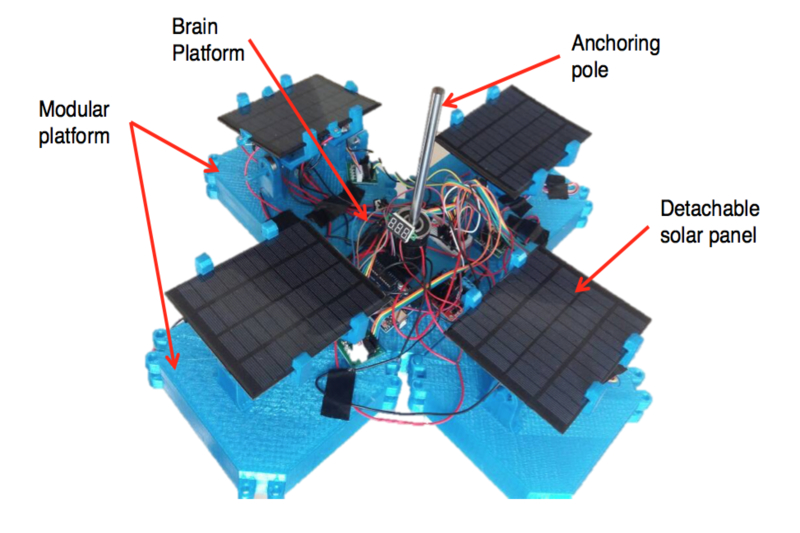
Bachelors students of Mechanical Engineering at the Universiti Tenaga Nasional (Uniten) began making plans for designing an automated solar PV (photovoltaic) system upon learning that 43.5 per cent of electricity in Malaysia was generated by gas, 42.5 per cent by coal and less than 0.3 per cent, according to a recent report.
The idea of the automated solar PV system on water came about and it was felt that this idea would be the best solution to the inefficiency of the current solar PV system and the land scarcity issue in Malaysia.
The students found that there is an abundant amount of water areas in the country, and most of these spaces are not being fully utilised.
There are more than 50 lakes in Selangor alone, and 90 per cent of these lakes are underutilised.
Therefore, the students thought that it would be a great idea to fully exploit the unused area of water and create a floating platform that is automated so that solar energy can be efficiently harvested.
They want to improve the green technology in Malaysia and eventually increase the percentage of the solar power generation in the Malaysia energy mix.
Since then the students have actively developed the smart and sensitive solar floating platform called Senslar. It is a portmanteau of the words solar and sensitive. It is a floating platform system that is sensitive to sunlight and can smartly move according to the sun’s position.
The student team and their team adviser believe that Senslar can have a valuable impact on the renewable energy industry in Malaysia and globally as this will promote the use of solar panels on underutilised surface areas of lakes, dam reservoirs and oceans.
The group first worked on Senslar to join a mini design competition held in Uniten. The prototype, which was a single and small unit of a floating solar platform (5cm by 5cm) got the group the second place.
Then they improved the design by adding innovative features to the original prototype and challenged themselves to compete at the International Invention, Innovation and Technology Exhibition (ITEX).
Four months before the event, they generated many conceptual designs, optimised the programming code for the tracking system and added features such as the tilting motion, modular function, ‘brain’ module, electrical ring connector and the anchoring pole for the vertical motion.
The team also tested the efficiency of the improved automated design with 8 Watt solar cells, and it was proven that this concept can harvest about 60 to 80 per cent more energy than a static module.
During the proof-of-concept model development process, we spent roughly around RM1,200 (including materials, manpower, fabrication and manufacturing cost).
The team purposely kept the design procedure inexpensive to ensure the design’s manufacturability and cost-effectiveness throughout the development process.
The team won a silver medal in ITEX 2018.
Since then, the group has built a small model of four Senslar platforms with each platform housing a two-watt solar cell, totalling to an eight-watt Senslar system. This small system can basically power up an LED light or a clock. It can also be used to charge a power bank to a full level for more than 40 hours with direct sunlight depending on the power bank capacity.
Installing the system on water not only overcomes the issue of limited space, but the water also plays the role of a cooling agent for the solar PV, reducing maintenance costs incurred by conventional PV systems.
However, it is important to note that Senslar is not designed for small applications. The team foresees that it will replace old, inefficient, stationary, solar floating farms in Malaysia. One of the examples is the solar floating farm on Sungai Labu, Selangor, which has about 432 panels (108kWp) that theoretically can provide electricity for 20 houses annually.
With Senslar, the energy harvesting efficiency can be improved to more than 40 per cent and the number of houses that receive the electricity can be potentially doubled.
The team has tested the proof-of-concept model, and it was proven that system works very well as the model can optimally tilt and rotate while effectively harvest direct sunlight, increasing the efficiency of solar energy harvesting to more than 40 per cent based on their lab test.
The team has started a company called Senslar Tech and are actively looking for partners or investors through competitions and meetings to support this project.
Beginning in 2019, the team will be installing and rigorously testing a few Senslar units on various targeted lakes. In five years, they plan to install Senslar on several lakes in Malaysia, especially in Selangor, Putrajaya and Cyberjaya.
In the next 10 years, the aim is to be one of the leading power supply companies in Malaysia with their solar panels installed in Peninsular Malaysia.
















